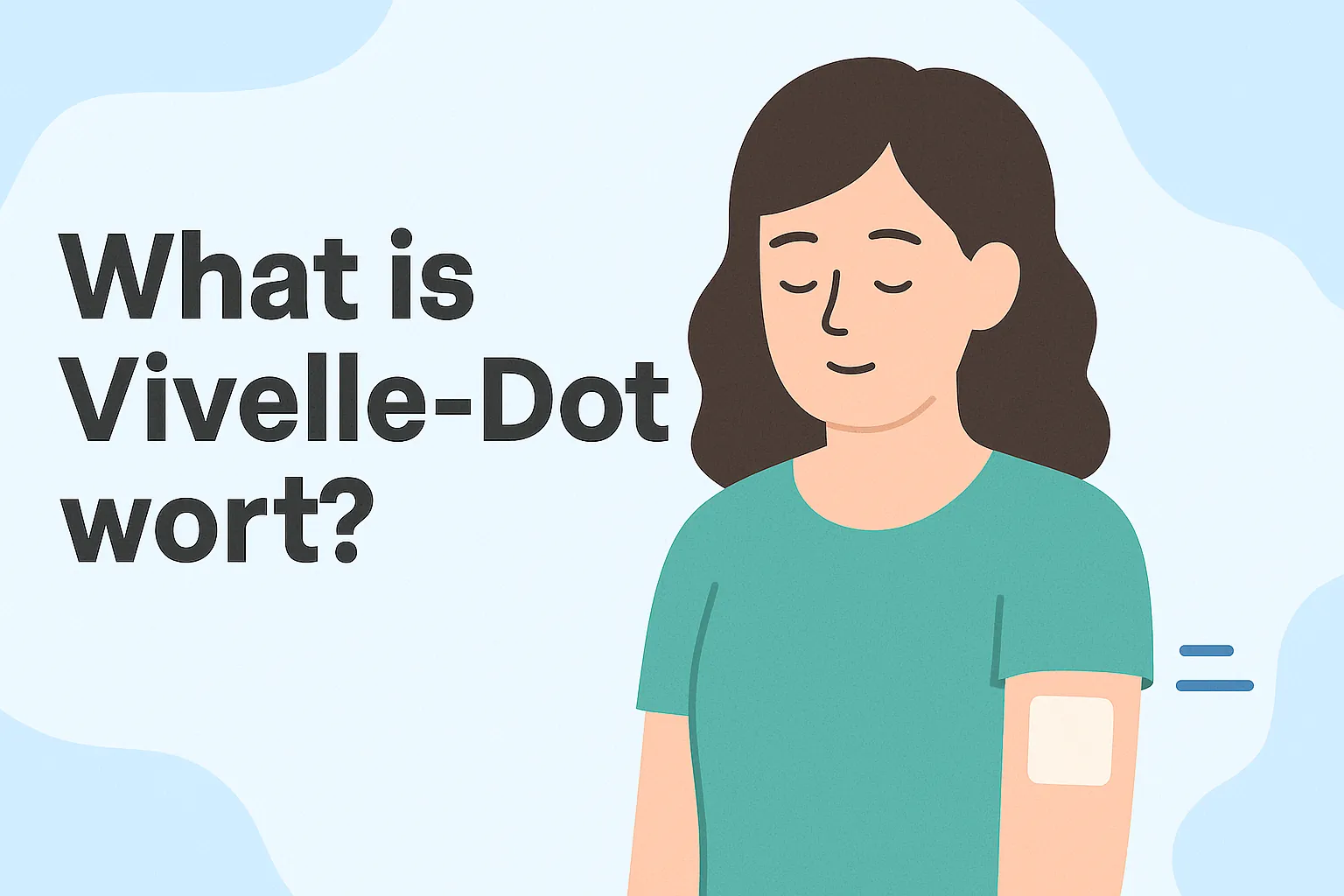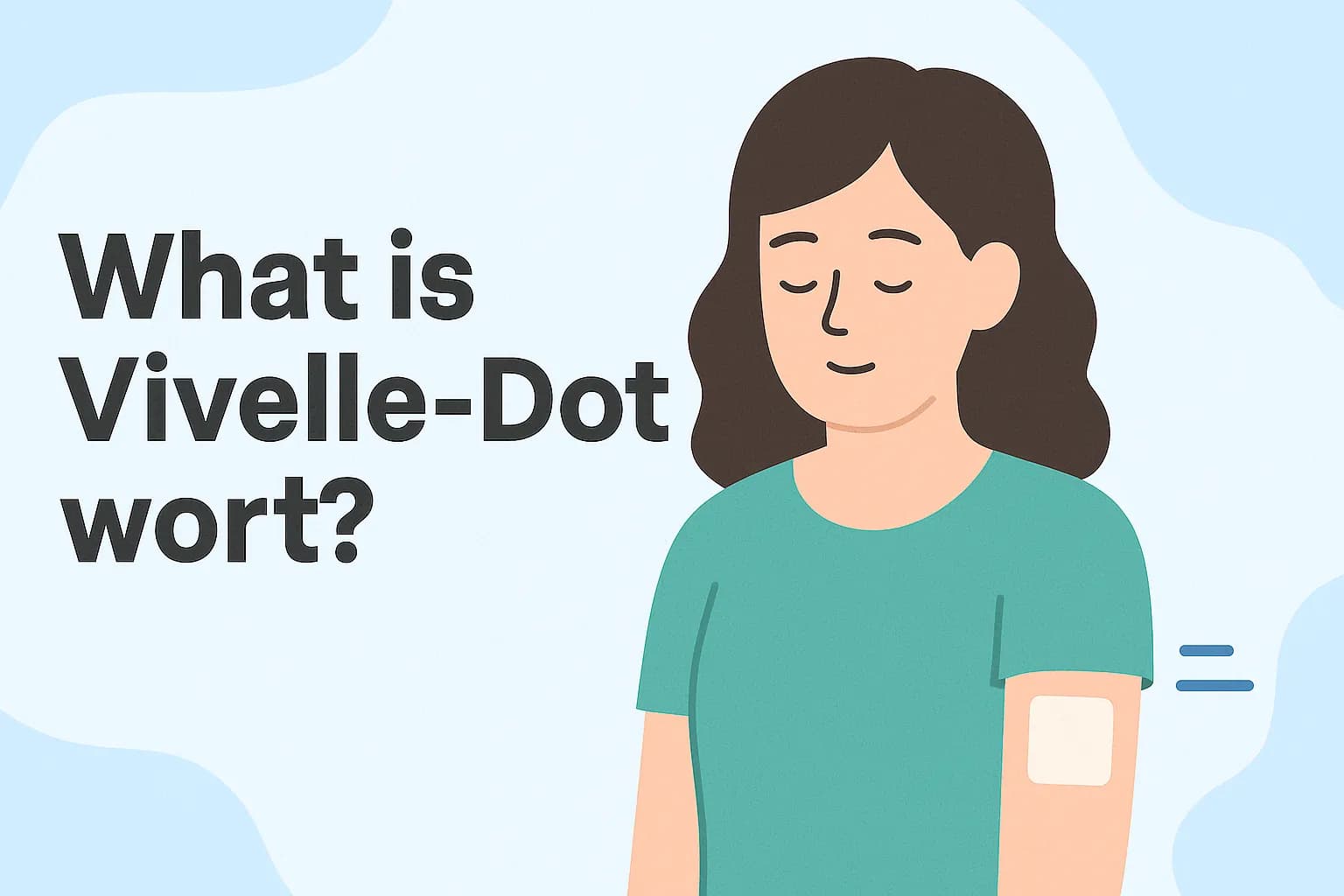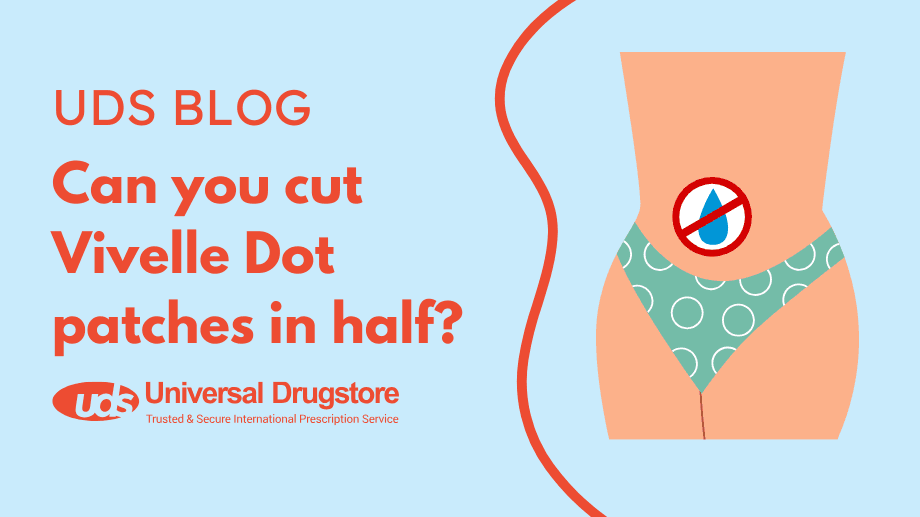What is Vivelle-Dot?

Vivelle-Dot (estradiol transdermal system) is a brand-name patch that you change twice weekly to help manage symptoms of menopause such as hot flashes, vaginal dryness, and night sweats. It is also used to prevent postmenopausal osteoporosis (bone loss). Transdermal estrogens such as this medication typically have fewer side effects than estrogen taken by mouth. However, Vivelle-Dot may sometimes cause serious side effects such as an increased risk of blood clots, stroke, heart attack, and certain cancers. For this reason, this medication should be given at the lowest effective dose for the shortest amount of time needed.
Keep reading as we will go into more detail about what Vivelle-Dot is used for, its side effects, and answer some frequently asked questions.
Vivelle-Dot FAQs
What is Vivelle-Dot used for?
Vivelle-Dot is approved by the U.S. Food and Drug Administration (FDA) to increase estrogen levels to treat menopausal symptoms and prevent osteoporosis in postmenopausal women or women without a uterus.
What are the side effects of using Vivelle-Dot?
The most common side effects of Vivelle-Dot seen in clinical trials include:
- Headache
- Breast tenderness or pain
- Flu-like symptoms
- Stomach pain
- Fluid retention/swelling
- Body or back pain
- Depression
- Vaginal bleeding or spotting
- Upset stomach
- Weight gain
- Bloating
- Skin redness/irritation at the application site
- Vaginal discharge
- Itching
- Nausea
Other possible side effects of Vivelle-Dot include:
- High blood pressure
- Hot flushes
- Facial hair growth
- Joint pain
- Muscle weakness
- Gas
- Constipation
- Anxiety/nervousness
- Trouble sleeping
- Stuffy nose
- Fungal infections
Rarely, Vivelle-Dot may cause severe side effects such as:
Serious, life-threatening allergic reactions, including anaphylaxis
Symptoms of anaphylaxis may include hives (raised red patches on your skin), skin rash, swelling of your face, lips, tongue, or throat, and shortness of breath. Seek immediate medical attention if you experience any symptoms of a serious allergic reaction.
Increased risk of endometrial cancer
If you have any unusual vaginal bleeding, notify your healthcare provider as this could be a sign of endometrial cancer (cancer of the lining of the uterus). Using Vivelle-Dot for more than a year can increase your risk of this type of cancer. If you still have your uterus, you should also take a progestin medication along with your patch, as this is the best way to prevent this problem.
Increased risk of breast cancer
The longer you take Vivelle-Dot, the higher your risk will be of developing breast cancer. That is why you should use this medication at the lowest dose for the shortest amount of time needed. If members of your family have had breast cancer or if you have ever had breast lumps or an abnormal mammogram, you may need to have breast exams more often.
Blood clots, heart attack, and stroke
Vivelle-Dot can increase your risk of blood clots, which can be very dangerous and lead to a heart attack, a stroke, or a pulmonary embolism (life-threatening blood clot in the lungs). Seek immediate medical attention if you have pain in your legs or arms, chest pain, sudden severe headaches, trouble breathing, or sudden changes in your speech or vision.
Dementia
Women taking medications that contain estrogen, like Vivelle-Dot, might have a higher risk of developing dementia. Your risk is highest if you start using Vivelle-Dot for the first time after age 65.
Gallbladder problems
Vivelle-Dot can cause you to have gallbladder problems and some people have had to have their gallbladder removed after starting this medication. If you experience stomach pain, nausea, or vomiting that doesn’t go away, fever, or a yellowing of the skin and eyes (jaundice), notify your healthcare provider right away.
Pancreatitis
Vivelle-Dot can increase your triglyceride (blood fats) levels, which can cause heart problems or inflammation of your pancreas. Your healthcare provider might order regular blood tests to watch for this while you are using this medication. If you experience sudden stomach or back pain, nausea, vomiting, sudden weight loss, or a fast heart rate, contact your provider or get medical attention right away.
These are not all of the possible adverse events of Vivelle-Dot. You should always seek medical advice from a healthcare professional for any questions or concerns about your medical condition or treatment. You should also read all the patient information, including your Medication Guide that comes with Vivelle-Dot. You can report side effects to the FDA at 1-800-FDA-1088 or www.fda.gov/medwatch.
What does Vivelle-Dot do?
The active ingredient in Vivelle-Dot is estradiol, which is a synthetic form of the estrogen hormone. Estrogen is a female sex hormone produced by the ovaries and is necessary for many processes in the body. Vivelle-Dot replaces estrogen hormones that your body loses during menopause. Replacing estrogen helps prevent bone loss and relieves symptoms of menopause, such as hot flashes and vaginal dryness.
What should you tell your healthcare provider before using Vivelle-Dot?
You should not take this medication if you have an allergy to estradiol or any of the inactive ingredients in this product. You should be sure your healthcare provider is aware of all your medical conditions as they may be contraindications or you may need increased monitoring during treatment, including:
- Any unusual vaginal bleeding (spotting, breakthrough bleeding, prolonged/recurrent bleeding)
- Cancers such as breast, uterine, or ovarian cancer
- Certain blood disorders such as porphyria
- Blood clotting disorders such as protein C or protein S deficiency
- Heart disease
- Previous heart attack or stroke
- Gallbladder disease
- Kidney disease
- Liver disease
- Hereditary angioedema (an immune system disorder)
- High cholesterol/triglycerides
- Uterine fibroids (benign tumors in the uterus)
- Endometriosis
- Migraine headaches
- Underactive thyroid (hypothyroidism)
- Diabetes
- Seizures
- Asthma
- High calcium levels in your blood
- Pregnant, plan on becoming pregnant
- Breastfeeding or plan to breastfeed
Are there any drug interactions with Vivelle-Dot?
When Vivelle-Dot is taken with other prescription drugs, over-the-counter medications, vitamins, herbal products, and supplements, it may change how they work or increase the risk of side effects. Tell your healthcare provider about all your current medications, including:
- CYP3A4 inducers such as phenobarbital, carbamazepine, rifampin, or St. John’s wort
- CYP3A4 inhibitors such as erythromycin, clarithromycin, ketoconazole, itraconazole, ritonavir, and grapefruit juice
How do you apply the Vivelle-Dot patch?
Place the adhesive side of the Vivelle-Dot patch on a clean, dry area of the trunk of your body including the buttocks or stomach. This area should be clean, dry, and free of powder, oil, or lotion for your patch to stick to your skin. Do not apply Vivelle-Dot to your breasts and avoid the waistline, as tight clothing can rub the patch off. When applying, hold the patch firmly in place with the palm of your hand for around 10 seconds.
When changing your patch on your twice-a-week schedule, apply the new patch to a different site. Do not apply a new patch to that same area for at least 1 week. If your patch falls off, reapply it or apply a new patch in a different location. Either way, you should continue your original treatment schedule.
How long should you use Vivelle-Dot?
Vivelle-Dot should be used at the lowest effective dose and for the shortest amount of time. You should discuss the use of this medication with your healthcare provider every 3 to 6 months to see if you still need it. If you will be using Vivelle-Dot long-term, you should have regular physical exams and mammograms as directed by your healthcare provider.
Is Vivelle-Dot being discontinued?
The Vivelle brand name has been discontinued in the U.S. If generic versions of this product have been approved by the FDA, there may be generic equivalents available.
Can you shower with Vivelle-Dot?
Yes, you can take baths, showers, or swim while using this medication, as it will not affect the patch’s effectiveness. If your patch falls off, simply reapply it to a different location. If the patch will not stay on, replace it with a new one while keeping your original patch-changing schedule.
Related Medications
- Climara (estradiol patch)
- Climara Pro (estradiol/levonorgestrel)
- Alora Patches (estradiol)
- Minivelle (estradiol patch)
- Menostar (estradiol)



